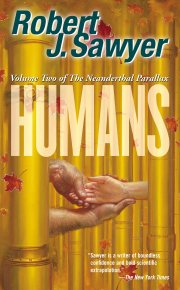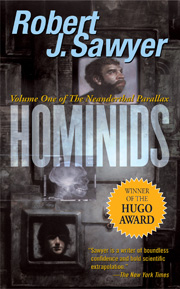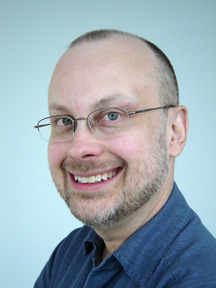
In honor of the release of the Italian edition of my novel
Humans, second volume of my Neanderthal Parallax trilogy, Sosio Silvio conducted a by-email interview with me, although many of the questions were actually about the upcoming
Flash Forward TV pilot. The Italian version of the interview is online at Fantascienza.com
here, and the orginal English is below.
Your novel Flash Forward has been chosen to be developed into a TV series. Can you tell us something about the idea on which the novel is based?In 1975, when I was in grade 10, I founded my high-school's science-fiction club. Twenty years later, in 1995, we had a reunion party. We were all amazed at how differently our lives had turned out from what we'd expected. Several members of our group had been married and divorced in the interim, and practically no one had the job he or she thought they were going to get. Me, I'd been planning on becoming a paleontologist; Ted had his sights set on becoming a veterinarian; Rick was going to be a filmmaker; and Bruce was going to be a police officer.
Twenty years later, I was a science-fiction writer. Ted had become a computer programmer. Rick had become a lawyer. And the guy who wanted to be a cop was now a
cordon bleu chef.
We all kept saying the same thing about our high-school days: if I had known then what I know now, how much better things would have been!
Well, a science-fiction writer can't hear a comment like that without wanting to put it to the test. And so the novel
Flash Forward was born. In it, an experiment goes awry at CERN, the European Center for Particle Physics, causing the consciousness of everyone on Earth to jump ahead twenty-one years for a period of two minutes. Suddenly people know for an absolute fact how their lives, their careers, and their marriages are going to turn out. The novel details the impact such knowledge has, both for good and bad. Of course, a two-minute glimpse can be frustratingly ambiguous. Could you go ahead with a planned wedding knowing that two decades hence you would be married to someone else? How would you greet the imminent birth of your first child if you knew that he'd grow up to be a vicious, surly thug?
As with many of my novels,
Flash Forward tries to combine a mind-stretching idea with a very human story. Indeed, I think science fiction is at its best when it lets us examine the human condition under circumstances that no one has ever encountered before -- that's what makes the genre anything but formulaic, and endlessly fascinating to write.
The story has been adapted for the TV series? There are important changes from the original story of the novel?Brannon Braga and David S. Goyer have put their stamp on it, and, yes, they've made some changes. I've frankly been surprised about how concerned they've both been that I be comfortable with the changes: when you sell something to Hollywood, you give up creative control. But right from our first meeting in 2007, David and Brannon have seemed genuinely concerned that I be happy with what they've done. And, indeed, I am -- very happy.
We're hoping
Flash Forward will run five or six 22-episode seasons, so they've had to expand my novel, which, if you filmed every scene in it, might have made an eight-hour miniseries, into over a hundred hours of drama, and I'm delighted with the very clever approach they've taken.
It's the first time that you sell a work to Hollywood?I've had lots of books optioned before, and good screenplays have been written based on some of my novels, but nothing has ever actually gone into production. I'm absolutely thrilled, and my wife and I are heading down to Hollywood to watch the filming of the pilot.
Have you been involved in the development of the series?Contractually, I am consultant to the series: I was paid to provide input to the pilot script, and will be paid to provide input to every episode of the series. I'm also contracted to write one of the first-season episodes. The novel is mine, but the series is David and Brannon's. I'm determined to help them realize their vision.
Have you met Brannon Braga? What do you think of him?Yes, indeed. I was thrilled to meet Brannon. He is extremely intelligent, extremely creative, and a nice guy, to boot. I'm a long-time
Star Trek fan, and Brannon, of course, co-authored "All Good Things ...," the finale of
Next Generation, and
First Contact, arguably the best of the
Star Trek movies, so meeting him was a total thrill.
This month in Italy has been published Humans, the second book of the cycle The Neanderthal Parallax. I've really appreciated the first book, Hominids. Can you tell us something about this sequel?The structure of the trilogy is this: In
Hominids, the first book, a modern-day Neanderthal male -- the quantum physicist Ponter Boddit -- who lives in a parallel world where our kind of humanity is extinct, comes to our version of reality.
In the second volume,
Humans, a modern day
Homo sapiens female -- the geneticist Mary Vaughan -- travels to the Neanderthal version of reality.
And in the third,
Hybrids, they try to discover the best of both worlds; ultimately, I think of it as a utopian series.
I hope to see that third volume, Hybrids, in Italy very soon. This is definitely the end of the story?Yes, indeed. The series was conceived of as a trilogy at the start, and it ends with a definite bang. Some have actually taken me to task for providing definite conclusions: one of the plotlines deals with Ponter's atheism, a trait shared by all Neanderthals, and Mary's Roman Catholicism; another deals with Ponter's bisexuality and polyamory, again, a trait shared by all Neanderthals, and Mary's heterosexuality and monogamy. Those come to very definite climaxes in the third book, which, depending on your points of view, you'll either love or hate -- but, either way, I hope will make you think.
What are you writing now?A trilogy about the World Wide Web gaining consciousness. The first volume,
Wake, will be out in April 2009, to be followed by
Watch and
Wonder. Many people -- including my New York and Hollywood agents -- seem to think
Wake is the best thing I've ever written; following that up with two sequels is daunting, but I'm working hard to make sure the next two books are just as good.
The Robert J. Sawyer Web Site
Labels: Flash Forward, Flashforward, Hominids, Humans, Hybrids, Neanderthal Parallax





